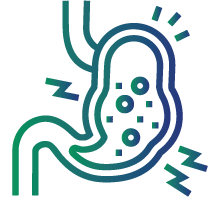
Inhibin B Test
Inhibin B
This test measures the levels of inhibin B in the blood. Inhibin B is a polypeptide hormone secreted by the Sertoli cells in the testes and the Granulosa cells of the ovary. It stops the pituitary from producing Follicle Stimulating Hormone (FSH).
Inhibin B hormone is associated with conception, the maturation of eggs in women, and the development of sperm in men. Normally, the placenta normally produces inhibin A and B hormones during pregnancy; however, in cases of ovarian cancer, abnormal production of these hormones occurs. Both inhibin A and B hormones help maintain pregnancy. Their levels are crucial for both a healthy pregnancy and feotal development.
Inhibin B is associated with the maturation of follicles in the ovaries in females. Follicles are sacs that give rise to mature eggs. During each menstrual cycle, inhibin B rises and falls at various times. Inhibin B contributes to sperm production in the testicles of males. Inhibin B levels are usually higher in men with normal fertility than in men who do not produce enough viable sperm.
Inhibin B testing is commonly recommended to detect ovarian tumours, assess fertility in both men and women, and also evaluate the health of the developing fetus in pregnant women
Symptoms of ovarian cancer

Fatigue

Upset stomach

Back pain

Pain during sex

Constipation

Changes in a woman's menstrual cycle

Abdominal swelling with weight loss
Preparation for test
No special preparation is required for an inhibin B test
Interpretation of results
The units of measurement for the results are Picograms Per Milliliter (pg/mL)
|
Age |
Males Reference range in pg/ml |
Females Reference range in pg/ml
|
|
< 1 month |
133-196 |
9-31 |
|
1 month- < 1 year |
195-256 |
23-94 |
|
1- <10 years |
91-163 |
8-37 |
|
10- < 20 years |
169-216 |
22-85 |
|
20- < 40 years |
151.7-173.9 |
21-53 |
|
40- < 60 years |
134.7-150.5 |
< 5-33 |
|
>60 years |
126.5- 151 |
Non-detectable |
Deviation from normal levels indicates the following:
· An inhibin B level in the postmenopausal range (40–60 years) is indicative of a diminished or depleted ovarian reserve when used to evaluate infertility.
· Elevated inhibin B levels are indicative of granulosa cell tumors or epithelial ovarian tumors.
In ovarian cancer patients who are being monitored, inhibin B levels drop to extremely low or undetectable levels shortly after surgery. Elevated inhibin B levels following therapy might be because of a persistent, recurrent, or progressing illness. Increased inhibin B levels appear to occur earlier than clinical symptoms in patients with recurrent disease. Inhibin B levels are normal in patients who are in remission
FAQs
How is the sample collected for an inhibin B test?
A blood sample is collected from a vein in your arm using a small needle. Usually, this process does not take more than 5 minutes
What are the risks involved in the inhibin B test?
This test involves negligible risk. There might be slight pain or tenderness around the site where the needle went in. Rarely, the site can become infected
What is the turnaround time (TAT) for the results of an inhibin B test?
Results of an inhibin B test are usually available within 10 days; however, it could take longer at times
When is an inhibin B test ordered?
When you and your partner have been struggling with infertility, inhibin B testing may be ordered by your doctor. When a couple has unsuccessfully tried to become pregnant for 12 months or longer, infertility is typically diagnosed. Prior to an assisted reproductive procedure, such as in-vitro fertilization, women may be recommended to take an inhibin B test to help assess ovarian reserve. Additionally, an inhibin B test might be ordered for the diagnosis of ovarian cancer
What are the limitations of inhibin B test?
Human anti-animal antibodies (HAAA) may be circulating in some patients who have been exposed to animal antigens, either naturally or as a result of medical treatment or imaging procedures. These antibodies may cause unreliable inhibin B test results by interfering with the assay reagents.
Inhibin levels change throughout the menstrual cycle. Premenopausal women's inhibin levels should be interpreted cautiously. Additionally, serum inhibin levels should not be interpreted as conclusive evidence for the presence or absence of malignant disease. This test’s findings should be used in conjunction with data from the patient's clinical evaluation and other diagnostic tests

